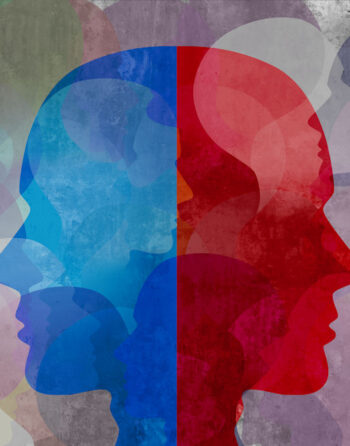What’s the Difference Between BPD and Bipolar Disorder?
Borderline personality disorder was first recognized in the 1980 edition of the Diagnostic and Statistical Manual of Mental Disorders and has been controversial ever since. One controversy is whether BPD is related to bipolar disorder or not since they have many similar symptoms.

Mood changes can often be a natural response to a stressful situation. However, some people’s mood shifts are so extreme that they could signal more serious conditions. Both of these conditions feature major mood changes. This similarity in mood shifts causes many people to confuse the two disorders.
Are BPD and Bipolar Disorder Related?
They are related, but they are separate conditions with different patterns and require different treatments. They share many common features and the most critical overlapping characteristic is mood instability. About 20% of bipolar II and 10% of bipolar I patients have co-occurring BPD. There is a strong relationship between bipolar disorder and BPD.
Similarities of Bipolar Disorder and Borderline Personality Disorder
Both BPD and bipolar feature unstable moods and both can cause intense mood shifts. This includes periods of:
- extreme sadness,
- anxiety, or
- irritability.
Bipolar disorder is linked to mood shifts from depression to mania or hypomania. Mania features
elation, less need for sleep, and increased activity. Hypomania is less severe. On the other hand, individuals with BPD often change from feeling fine to severely distressed in a matter of minutes.
Both disorders lead to impulsive behavior. This may include:
- unsafe sex,
- reckless driving,
- spending sprees, and
- drug misuse
Both disorders heighten the risk of suicidal activity.
Rates of substance use are increased in both disorders.
Both can cause emotional dysregulation. This brain-related symptom means the person has problems managing their emotions and feelings and may react in a way that is not proportional to the situation.

BPD Symptoms vs Bipolar Disorder Symptoms
When comparing BPD vs. bipolar it’s important to know that as a type of personality disorder, BPD causes people to think, feel, relate, and act differently than individuals who don’t have it. Bipolar disorder is a type of mood disorder. It is in a category of illnesses that can lead to severe mood swings.
Individuals with BPD have an ongoing cycle of variable moods, self-image, and behaviors. These patterns usually cause problems that affect the person’s life, relationships, and how they relate to and understand others. The National Institute of Mental Health has reported that about 1.4% of adults in the U.S. have BPD.
Bipolar affects the person’s energy, mood, thoughts, activity levels, and functionality in cycles that last for days or even months. Bipolar is more common than BPD and affects about 2.6% of the population in the U.S.
- Extreme mood swings
- Extremely heightened mood
- Restlessness
- Increased activity and energy levels
- Reduced need for sleep
- Aggression or irritability
- Racing thoughts or speech or both
- Exaggerated sense of self-importance, conceit
- Extravagant ideas
- Risky, reckless behavior
- Impulsiveness
- Psychosis (lost touch with reality) during extreme manic episodes
- Fatigue
- Feeling worthless and guilty
- Difficulty concentrating or making simple decisions
- Aches and pains with no explanation
- Continual sadness
- Unexplained crying
- Noticeable changes in appetite and sleep patterns
- Agitation, anger, and irritability
- Pessimism and apathy
- Extreme worrying and anxiety
- Loss of pleasure in previous interests
- Withdrawing socially
- Thoughts of suicide and death
Not everyone with bipolar disorder will have depression. Experiencing manic episodes is the only requirement for a diagnosis of bipolar I disorder.
- Rapid mood changes
- Uncertainty about their role in the world
- Distorted sense of self or self-image
- Changing interests and values frequently
- Quickly changing opinions about others–a friend one day and an enemy the next and closeness to hate and anger
- Unstable, intense relationships with friends and family–feelings alternate between love
- Emotional dysregulation
- Fear of being abandoned
- Identity disturbance–inconsistency in their identity
- Problems with anger
- Impulsive or reckless behavior
- Feelings of being worthless
- Paranoia
- Impulsiveness
- Suicidal thoughts or self-harming behaviors such as cutting, burning, or overdosing
People with BPD don’t necessarily experience all of these symptoms. Some people experience frequent and severe symptoms, while some only have a few minor symptoms.
How to Tell Whether I Have BPD vs. Bipolar Disorder
People with bipolar disorder cycle through mood episodes that go for at least 4 to 15 days. But people with BPD have short-lived constant shifts in moods. These shifts are also commonly triggered by relationship issues, negative thoughts, and other external and internal influences.

Can I Have Both?
You can. BPD and bipolar disorder often co-occur. According to a 2019 study, 2.2- to 16.1% of people with BPD also have bipolar I, and 4.8- to 18.7% of people with BPD also have bipolar II. The main difference between I and II is the duration and severity of the manic periods.
Causes of BPD vs Bipolar Disorder
Although the exact causes of BPD and bipolar disorder aren’t fully understood, it has been suggested that a combination of factors contribute to their development. They are:
- Bipolar disorder: A significant risk factor is family history. This points to a strong genetic element where genes related to brain chemistry and the function of neurotransmitters may be involved.
- BPD: Genetics may also play a part in BPD but environmental influences like trauma are more striking.
BPD: Developmental factors such as childhood trauma, sexual or physical abuse, and emotional neglect likely add to the development of BPD. Mood shifts in BPD are usually a reaction to an environmental stressor.
BPD and Bipolar Disorder: It is suspected that imbalances in certain neurotransmitters like dopamine, serotonin, and norepinephrine contribute to mood dysregulation in both conditions.
It’s important to understand that in cases with a history of trauma, BPD seems to come from the combination of temperament and trauma and not just trauma alone. Many people who experience trauma do not go on to develop serious psychiatric disorders.
Treatment for Mental Illness
Since bipolar disorder and BPD are different conditions, it’s important to treat each one individually for the best outcome.
There isn’t any medication that can successfully treat BPD. However, some medications help reduce some of the specific symptoms, such as anxiety. Additionally, evidence-based methods of psychotherapy are the treatment of choice.
Although BPD was previously thought to be challenging to treat, recent evidence shows that treatments can be effective. Most of the time it is treated with psychotherapy, but medications may also be prescribed to manage certain specific symptoms.
One such therapy is dialectical behavior therapy (DBT), which is based on the assumption that people with BPD don’t have the skills needed to tolerate intense thoughts and emotions. DBT is a form of psychotherapy that was created specifically to treat BPD. This method is a form of cognitive behavioral therapy (CBT) that teaches people:
- Stress management
- Relationship skills
- Emotional regulation
Mentalization-based therapy helps people recognize their mental states and be aware of them in relationships with others. Other helpful therapies include:
- CBT
- Group therapy
Sometimes, medications are prescribed to treat BPD symptoms. They include:
- Anti-anxiety medications
- Antipsychotics
- Mood stabilizers
Bipolar Disorder
Medications are the main treatments for bipolar disorder, although psychotherapy can also be effective. Mood stabilizers help balance moods and lower the risk of experiencing the extreme highs and lows. The first medication developed for treating bipolar disorder is lithium and it is still used today as a first-line treatment.
The types of medication that are frequently prescribed for bipolar disorder are antipsychotics and anti-convulsants such as:
- Abilify (apripiprazole)
- Depakote (divalproex sodium)
- Lamictal (lamotrigine)
- Haldol (haloperidol)
- Topamax (topiramate)
Cognitive behavioral therapy is widely used at all stages of bipolar disorder except for extreme mania. It helps the individual recognize negative thought patterns and behaviors and replace them with new, healthier behaviors.
This involves the entire family therapy working together to build communication skills, recognize risks, and learning how to manage warning signs of mood swings.
This helps people learn more about bipolar disorder including how to recognize warning signs and triggers and develop coping methods.
Other effective therapies include:
- Electrovonvulsive therapy (ECT) and
- Interpersonal and social rhythm therapy (IPSRT)
- Peer support programs
- Substance abuse programs
Receive Mental Health Treatment at NIRC
If you’re suffering with bipolar. BPD, or any mental health problem, including substance use, we are here to help. Northern Illinois Recovery Center is prepared to assist you with any mental health problem and we have achieved outstanding outcomes. Unfortunately, mental health issues go hand in hand with addiction. People frequently try to treat their problems on their own by abusing substances. It doesn’t work. It only adds another mental health problem.
NIRC has a dual diagnosis program designed to deal with that. Dont’t try this on your own. Contact us today and learn how to live the life you want.




